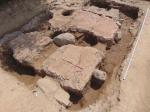Summary (English)
This was the fifth campaign of excavations on the Roman site of Tassignano di Capannori (LU), Tax C/82. The aim was to complete the investigation of room C and extend the excavation to the south and east.
The excavation data added to the picture formed at the end of the 2017 campaign, although there were no new elements regarding the interpretation of room C as a balneum.
Indeed, the excavations along the east side did not provide any useful evidence due to the presence of a modern ditch that has completely removed the pre-existing stratigraphy.The excavation was extended to the south in a strip about one metre wide with the aim of checking for the presence in this area of the structures necessary for heating the balneum. This was productive but not decisive. The excavation confirmed the presence of ‘traces of burning’, which could attest the presence of structures using fire, sealed by dumps of materials of late antique date. However, the complexity of the context suggested the research should be interrupted, given the limited size of the excavated area, until it could be extended further.
In room C, excavation of the robber trenches of the perimeter walls identified two successive interventions. One, late antique, during which the original walls and part of the paving were dismantled in order to build new perimeter walls on top of the demolished structures. The second, in the modern period, definitively robbed the walls.Thus, it appears there was late antique occupation on the site, as attested by the stratigraphy documented in the south extension, and by the burials documented in room A during the 2014 campaign.
Lastly, the demolition described above revealed the burial of a dog, whose skeleton was in the bottom of the western robber trench. The burial was probably originally at the base of the rebuilt perimeter walls, as confirmed by the fact that part of the skeleton lay beneath the floor of room C.The particular position of the deposition suggests it was part of the foundation ritual for the house, thus dating it to the late Republican period (2nd-1st century B.C.).
For the purposes of archeo-zoological study, it was decided to lift the skeleton.
- Alessandro Giannoni- Museo Archeologico Etnografico di Capannori (Lu)
Director
- Alessandro Giannoni- Museo Archeologico Etnografico di Capannori (Lu)
Team
- Elena Genovesi
- Fabrizio Burchianti
Research Body
- Gruppo Archeologico Capannorese
Funding Body
- Comune di Capannori
- Fondazione Banca del Monte di Lucca
- Istituto Comprensivo Carlo Piaggia di Capannori






![Download [PDF]](/excavation/skins/fasti/images/results/download_sml.png)